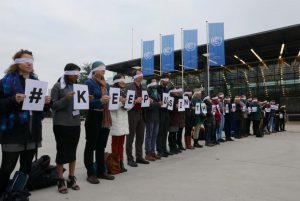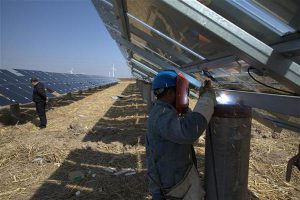Parties to the Montreal Protocol launched negotiations to phase down hydrofluorocarbons (HFCs) in Dubai this week, after nearly six years of preliminary discussion.
A long list of details are scheduled to be negotiated during a series of meetings next year during, both at an extraordinary Working Group meeting and an extraordinary Meeting of Parties. The Montreal Protocol is the only UN treaty where all 197 countries of the UN participate.
Many parties including the US, Mexico, Canada, island States, and the 54 countries of the Africa Group, wanted to move faster with the details this week, but Gulf States and India demanded delay on details until after COP 21 in Paris next month, raising a red flag about their tactics in Paris.
A rapid HFC phasedown under the Montreal Protocol could avoid the equivalent of up to 200 billion tonnes of CO2 by 2050, and 0.5C of warming by 2100, providing significant near-term gains to slow climate change.
HFCs are factory-made gases used primarily in refrigeration and air-conditioning, and are increasing at a rate of 10-15% per year making them fastest growing greenhouse gases in much of the world.
As Achim Steiner, UNEP Executive Director, noted in his prepared speech on Wednesday, parallel efforts to improve the efficiency of room air conditioners could save enough electricity to avoid building 2,500 medium-sized power plants by 2050, and 100 billion tons of carbon dioxide.
Steiner called on the parties to measure the success of the treaty through the impacts and benefits it has provided thus far. The Montreal Protocol is estimated to have avoided US$1.8 trillion in health costs, US$460 billion in livestock and food, and by 2030 will have prevented 2 million people from incurring cancer.
The UNEP chief asked: “What if we had let a small number of companies or countries block agreement to the Montreal Protocol and deny the rest of the world these benefits?” He urged agreement for the common good.
Formal proposals to phase down HFCs have been submitted by more than 40 parties, in addition to the informal proposal also submitted by the 54 countries of the Africa Group, for a total of 95 parties with proposals on the table.
Most of the parties are supporting the HFC amendment, although Saudi Arabia, Kuwait, Argentina, and India are still struggling to move forward, citing concerns over financing and the availability and performance of HFC alternatives in high-ambient temperatures. Senegal noted that while the Montreal Protocol has historically followed a consensus approach to its decision making, “consensus doesn’t mean unanimity.”
The US delegation is led by its equivalent to minister of environment, the Administrator of the EPA, Gina McCarthy, with representatives from the State Department, the White House, and other federal agencies on the the US delegation.
McCarthy made it clear during the opening of the high-level segment that the US and other donors were prepared to continue providing funding to help developing countries meet their obligations to phase down HFCs, once an amendment was agreed. “The structures are here. What we simply need to do is turn the lever that says go, then we are fully ready to run,” she said.
A recent study by the Oak Ridge National Laboratory concluded that already available alternatives to HFCs performed as well as or better in the hottest climates, addressing a key concern of those currently opposed of the amendment.
Another recent study by Lawrence Berkeley National Laboratory estimated that a modest 30% improvement of room air conditioners’ energy efficiency along with low-GWP refrigerants would avoid the equivalent of up to an additional 100 billion tonnes of CO2 by 2050, while also saving money for consumers. The combined transition of HFC replacements with energy efficiency improvements could avoid 25 billion tonnes of CO2 equivalent emissions by 2030, and 98 billion tonnes by 2050.
Saudi Arabia currently uses 70% of its electricity for air conditioning, and India and China use up to 50% during the hottest months of the year, so moving to more efficient air conditioning will bring huge benefits, including saving enough electricity to avoid building up to 720 medium-sized power plants in China by 2050, up to 511 in India, and up to 216 in Brazil. Globally, improving air conditioning efficiency could avoid up to 2,500 power plants by 2050.
In an effort to reach a consensus this year, the suggestion now on the table is a two-step approach for phasing down HFCs:
The first step is to freeze HFC production in developed countries, with the first reductions in 2019 (to 90% of the baseline) and again in 2024 (to 65% of the baseline). A 2021 freeze would be set for developing countries, to allow them time for further growth. The second step of the approach is to agree to set the rest of the phase-down schedule next year. This arrangement would capture more than two-thirds of the total climate benefits that a full HFC phasedown would provide, with the remaining benefits captured next year.
The spirit of discussions within the contact group has been positive thus far. This includes productive participation from China, once an opponent of the amendment, now acting as a co-chair facilitating the discussion. Pakistan, also once a vocal critic of the amendment, is now actively supporting the phasedown within the discussions. This comes after a bilateral agreement between President Obama and Prime Minister Sharif last month.
A paper released last week by the New Climate Economy, identifies the Montreal Protocol as a cost-effective and established pathway for reducing HFCs, recognizing that the global treaty has already successfully phased out nearly 100 chemicals similar to HFCs, and has been accepted by 197 countries, making it the only UN treaty with universal ratification.
The Institute for Governance & Sustainable Development’s Primer on HFCs is here.






